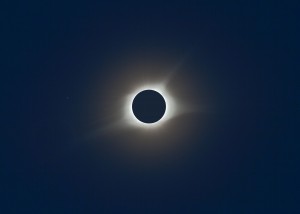![]() LISTEN to this week’s Sky Report
LISTEN to this week’s Sky Report
This is the Griffith Observatory Sky Report through August 30, 2017. Here’s what’s happening in the skies of southern California.
Now that Monday’s new moon and the accompanying solar eclipse are over, the moon is waxing and visible in the evening sky for a longer interval each successive night. Its setting time changes from 8:59 p.m. on the 23rd to 12:36 a.m. on the 30th.
The moon’s phase changes from crescent to first quarter on the 29th, and then to gibbous. Use a telescope to see lunar features dramatically side-lit by the rising sun along the terminator, the line that divides the moon’s day and night sides.
The giant planet Jupiter, in the constellation Virgo the Maiden, is visible for a short time low in the west-southwest after sunset. The bright planet sets at about 9:30 p.m.
Golden planet Saturn, in the constellation Ophiuchus the Serpent Bearer, is located in the south when darkness falls. It is perfectly positioned for the early telescopic observation of its beautiful system of rings. Saturn slips below the west-soutwest horizon at about 1:00 a.m.
The brightest planet, Venus, rises at around 4:00 a.m., about and hour before dawn starts. Venus is still visible and 30 degrees high in the east at sunrise.
Free views of the Sun during the day and of the moon, planets, and other celestial objects at night are available to the public in clear weather through Griffith Observatory’s telescopes from Tuesday through Sunday, before 9:30 p.m. Check our website for the schedule. The next free public star party on the grounds of Griffith Observatory, hosted by the Los Angeles Astronomical Society, the Sidewalk Astronomers, and the Planetary Society, will take place between 2 p.m. and 9:45 p.m. on Saturday, August 26th.
Follow the Sky Report on Twitter for updates of astronomy and space-related events.
From Griffith Observatory, I’m Anthony Cook, and I can be reached at griffithobserver@gmail.com.

